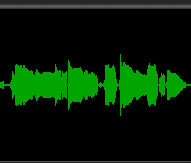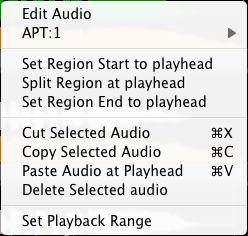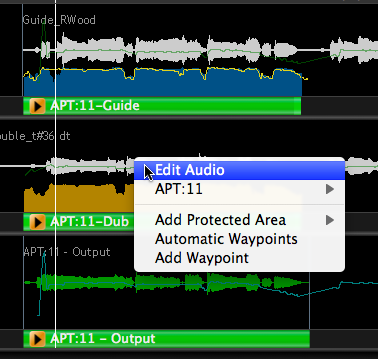Editing Signal Waveforms
In many cases, the way Revoice Pro works will mean you can bring long audio signals into Revoice Pro and not need to edit the waveforms. You can, in effect, create edits by inserting several Process Control Blocks to start and stop at specific points in each track of the input audio waveforms.
Therefore, the user might not have to edit the audio before bringing it into Revoice Pro or even after it is in Revoice Pro.
However, there are situations in which it is helpful to edit audio waveforms in Revoice Pro and this section explains the range of waveform editing operations available in Revoice Pro.
Selecting a waveform to edit
IMPORTANT: Because Revoice Pro supports editing of either the process controls or the waveforms in the same track, sometimes the user must switch Revoice Pro from Process Editing to Waveform editing. There are several "one-click" ways to do this, which will be described later in this chapter.
In many cases, a waveform is selected for editing by just LEFT CLICKing it once, and it will be displayed in green (as in image at the right) indicating it is selected.
Once a waveform is selected, then two familiar types of editing are available: screen-based and menu-based.
Screen-based waveform editing
Trim selected waveform start or endPositioning the cursor on the start or end of the selected waveform will show the blue "trimming" cursor and then holding down a LEFT CLICK will drag the selected start or end of the waveform. (See images to the right) |
  |
Move waveform positionPositioning the cursor away from the ends of the selected waveform will show the hand-shaped "drag" cursor and holding down a LEFT CLICK lets the user drag the selected waveform along the track. If the waveform is NOT an Output waveform it can be dragged into another track. (See image to the right) In Revoice Pro, waveforms are allowed to overlap (as shown in image to the right) and both will be played at the same time and processed as one signal. |
|
Menu-based waveform editing
 If no process has been assigned to a waveform, a RIGHT CLICK on a selected waveform will pop up the waveform editing options window, shown to the right for Mac OS. The Windows OS items will have slightly different commands as shown in both the on-screen menu and the Quick Keys guide.
If no process has been assigned to a waveform, a RIGHT CLICK on a selected waveform will pop up the waveform editing options window, shown to the right for Mac OS. The Windows OS items will have slightly different commands as shown in both the on-screen menu and the Quick Keys guide.
If the user has positioned the Playhead at a useful point before bringing up this window, then the three (self-describing) menu options can be used either to shift the selected waveform's start or end, or split it into regions.
Positioning the Playhead is done by either double LEFT CLICKing along the waveform, using the Scrub control, or pressing the space bar to stop playback. These are described in more detail here,
A further group of "standard" menu options allow the entire selected waveform to be Cut, Copied, Deleted or (if a prior operation copied a waveform and "Paste Audio ..." is not greyed out), the copied waveform can be Pasted to start at the Playhead.
Lastly, the Set Playback Range can be used to automatically set a Playback Range to the selected length of audio.
 If an APT or Doubler Process uses the selected audio waveform, the menu will have two additional options at the top, as shown right (for Mac OS).
If an APT or Doubler Process uses the selected audio waveform, the menu will have two additional options at the top, as shown right (for Mac OS).
If the audio is selected (green), selecting Edit Audio will actually deselect the selected audio. If the audio is not selected, then selecting Edit Audio will deselect a selected process and allow the audio to be selected to edit.
The next item in this example, "APT:1", shows the currently selected process and can be selected to switch to Editing Process-based items (such as Energy or Pitch).
Selecting Waveforms when in Process Editing Mode
As mentioned above, Revoice Pro lets the user select some Processes to edit Input and Output features. If the user is in an APT Process Editing mode, then LEFT CLICKing a waveform will not select it. The user must first switch that mode OFF before a waveform can be selected for editing. There are several quick ways to do this.
 Deselecting Process Editing Mode
Deselecting Process Editing Mode
- Hold down CMD key on keyboard and LEFT CLICK on a selected (green) Process Control Block to de-select that Process.
OR - RIGHT CLICK in a waveform area - and if it brings up the menu (shown to right), select Edit Audio to leave Process Editing mode.
Either of the operations above will exit the APT Process Editing mode and turn formerly green Process Control Blocks grey, indicating that mode was successfully turned off. You can then click on waveforms to select and edit them.
Recommended Approach to Efficient Processing
Using the Revoice Pro waveform editing options to change a waveform's start or stop or split it inside Revoice Pro is one approach to creating well-defined regions for processing a section at a time, and then create Process Control Blocks to match these regions.
However, the user will probably find it more advantageous and efficient to save time and not split waveforms and, instead, create a sequence of region-based Process Control Blocks whose ends and positions can be quickly and easily manipulated.



